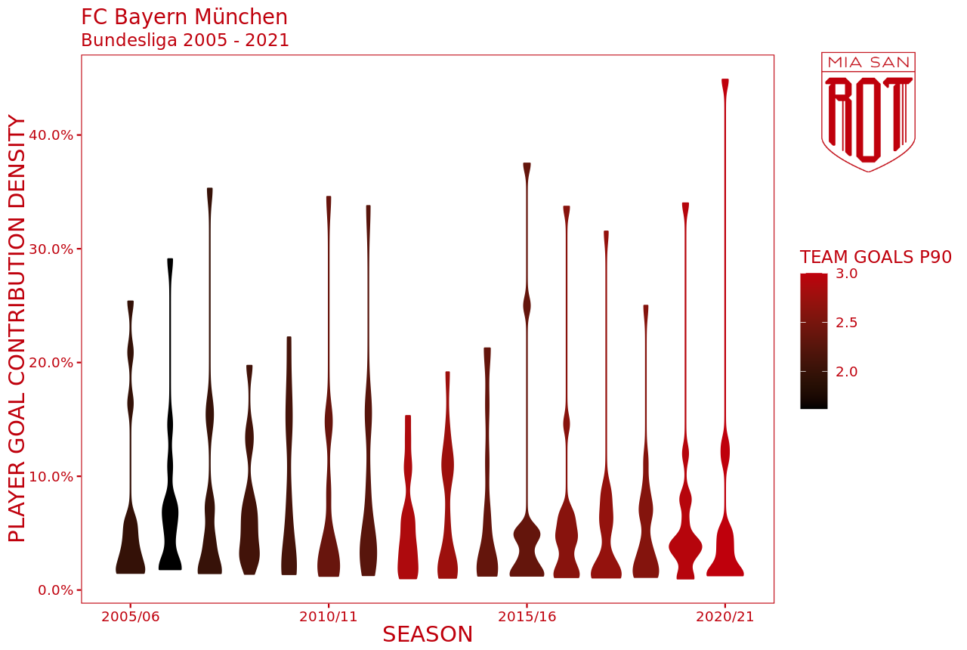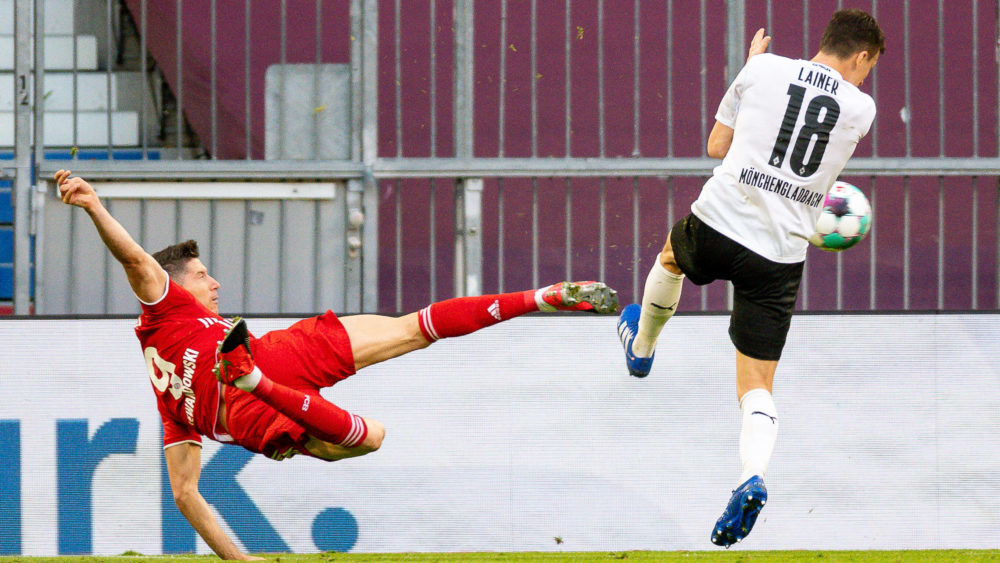Bundesliga MD 33 Preview: Freiburg vs. Bayern
One more goal and Lewandowski will ascend the Mount Olympus of Bundesliga history. For many years, Gerd Müller’s record was considered unbreakable. 40 goals in one season? Impossible. The development of football itself has contributed to this. Defensive lines became tactically cleverer and in attack, coaches built on more variable plays based on a broader set of players. In the 2000s, many teams used a setup with two strikers up front. This was accompanied by a broader distribution of goals among several players, something which hardly ever happened, or at least not in the same way, in the days of Gerd Müller.
If a striker scored between 25 and 30 goals, that was extraordinary. In principle, this is still true today. Anyone who scores that often is automatically one of the best players in the country. Even in international comparison, there have only been a few players who have reached the heights of Gerd Müller. Cristiano Ronaldo and Lionel Messi are two of them. But in the Bundesliga? Unimaginable.
Müller and Lewandowski in comparison
In the 1971/1972 season, when Müller set his record, he scored 40 out of 101 of his team’s Bundesliga goals, amounting to almost 40% of all Bayern goals. Such proportions gradually disappeared and where hardly ever reached again later. In the 2000s, there were only a few exceptions such as Marek Mintal, who scored almost half of all Nürnberg goals in the 2004/2005 season, or Aílton, who managed to score 28 goals in 2003/2004, equalling just under 35% of all Werder goals. Theofanis Gekas, who scored 20 of 49 Bochum goals in the 2006/2007 season, is also one of the outliers at the top. At FC Bayern, however, there never was a striker who even came close to such figures.
During most of the 00s, the Bayern team played with two strikers. In terms of overall goal share, Luca Toni’s 24 goals in the 2007/2008 season stand out with a share of about 35%. With the appointment of Louis van Gaal, however, the tide turned again. The Dutchman switched to a single striker setup, but at the same time accentuated the role of the wingers. Arjen Robben, in particular, went on to score many goals in the years that followed, and Thomas Müller also took on some of the responsibility to score goals. In the first season under van Gaal, the two even were Bayern’s Bundesliga top scorers: Robben scored 16 goals, Müller 13. The best center-forward was Ivica Olić with 11 goals.
But then the single center-forward setup came more into the focus again. With one season to go, Mario Gómez was now the lynchpin in the offensive. In 2010/2011, he scored 28 Bundesliga goals, accounting for around 34.5% of all Bayern goals. From then on, this was going to be the level of most attackers – with one major exception in the 2012/2013 season, when three attackers shared the position up front.
The return of the target man?
Robert Lewandowski himself came closest to the Gerd Müller percentage when he scored 30 Bundesliga goals in the 2015/2016 season, giving him a share of 37.5%. It can therefore be argued that, although Bayern increasingly relied on using a single striker up front in the 2010s, they also had two players in Robben and Thomas Müller who also scored a lot of goals.

But that is only part of the truth. The other is that Gerd Müller, in his outstanding record-breaking season, also had strong competitors in his own team. Uli Hoeneß scored 13 goals at the time, Franz Roth 12. Bayern were an offensive machine that set a record with 101 goals for a season, which for a long time seemed as distant as the Müller record itself. Last season, however, the team almost succeeded in reaching it, missing out on the record by only one goal. Lewandowski with his 34 goals seemed to have virtually maxed out what strikers are able score in football today in a world that rarely relies on a single target man in the front line for scoring the goals. This season, Bayern are close to 100 again.
Especially in the overall context of the Bundesliga, the development is remarkable. Among the top 5 in the Bundesliga, there are four teams that are statistically very dependent on one attacker. Frankfurt’s André Silva has so far scored 25 of 63 of Frankfurt’s goals (39.7%), Wout Weghorst 20 of the 57 Wolfsburg goals (35%), Haaland has scored 25 of a total of 69 Dortmund goals (36.23%), although he has been out for some time. And then there is Robert Lewandowski, who currently has 39 goals and a share of 42.4%. The return to a target man?
Lewandowski is statistically better than Müller already
Actually, very little has changed at Bayern. The game is still designed for offensive flexibility and, as was evident only last weekend, it is not Lewandowski alone who scores the goals. Thomas Müller also has 11 goals and Serge Gnabry 9, so the record for the most successful striker duo is also still at stake. The pair of Grafite and Edin Dzeko scored 54 times in 2008/2009. Lewandowski and Müller stand at 50 goals. Last season, when the Bayern side scored 100 goals, these were spread across 15 players, and so far this season it is 15 again, compared to 12 in the 1971/1972 season.
The goal rate per 90 minutes is also interesting when comparing the two exceptional strikers. Gerd Müller managed to stay on the pitch for the entire Bundesliga season twice. Once was when he managed to score 40 goals. Spread over 3060 minutes of play, that amounts to 76.5 minutes per goal. In contrast, Lewandowski’s rate this season is an incredible 58.5 minutes per goal. The Pole was on the pitch for only 2283 minutes in 27 appearances.
However, Lewandowski has also scored seven times from the spot. A statistic that is often viewed somewhat disparagingly, because penalties should not really be a challenge for a striker. However, Gerd Müller showed in his record-breaking season that scoring from the spot cannot be taken for granted. The “Bomber” missed three penalties at the beginning of the season, and subsequently did not take any more. And even without penalty kicks, Lewandowski currently scores one goal per 71.3 minutes – still a better value than Müller.
Is Lewandowski’s performance worth less than Müller’s?
The difference in the two players’ game times raises another question: Is it harder for athletes today to play through a complete season? The inflated game calendar, the much higher pace of play, and the undeniable risk of injury due to a high workload certainly seem to suggest that it could be. However, on the other hand there is the fact that the opponents’ style of play was much more robust back then and using crunching tackles to stop the opponent was less frowned upon. Bayern’s 1975 European Champion Clubs’ Cup final against Leeds is particularly noteworthy in this context. Franz Beckenbauer was furious about the English side after the game: “The dirtiest team I’ve ever met.”
The Bayern team also played many test matches, including in mid-week. For the club, this was an important source of income. While these matches cannot be compared to the competitive nature of a Champions League or DFB-Pokal match, the travel and all the surrounding hubbub were certainly not negligible. So the question as to whether today or back then was a more grueling time to play professional football cannot be answered conclusively. The fact that there are only a few players today who go the full distance of a Bundesliga season is probably also related to medical progress. The key word here is load management. The squads are composed to have strength in depth and in some cases it is easier to do without the top player.
In many places, the argument is put forward that Bayern have an easier time scoring goals in the Bundesliga today. It is true that the club is far ahead of their national rivals today, but a look at the 1971/1972 season also shows that they had virtual walk-overs back then already. Ten times Bayern scored at least four goals, once even eleven against Dortmund. This season, there have been 12 games with at least four Bayern goals.
Two games to become a legend
As already indicated, defensive lines in modern times are tactically better drilled and organized than in the seventies. That is probably one reason why the records of that era have endured for so long, and in some cases still do. On the other hand, it is also clear that the widening competitive gap between the top teams and the rest is playing its part in Bayern’s increasing development in a direction where those records seem to come within reach again. Nevertheless, the exceptional nature of Lewandowski’s season should not be underestimated.
Both Müller and Lewandowski have produced incredible performances that can hardly be praised highly enough. In the case of Müller, it should be mentioned that in his record season he not only missed three penalties, but also failed to score at all in 15 games. His 40 goals are thus spread over the remaining 19. Lewandowski, on the other hand, only failed to score in four games in which he appeared. In addition, he missed five games through injury or rest.
It takes an exceptionally consistent season to get even within eyeshot of 40 goals today – and even then it is hard enough. Now, however, Lewandowski has two games to score at least one goal and make himself a Bundesliga legend. However, he has to have himself under control, because there is still one threat hanging in the air that could derail his project at the last minute: if he is booked at Freiburg, he will miss the last game at home against Augsburg.
Two favourite opponents?
Otherwise, he “only” needs an average performance to break the record. Average with respect to the performances he has shown so far, and average with respect to the remaining opponents. Against Freiburg, the striker scores on average every 78 minutes. However, in the Bayern shirt, this has been once only every 106 minutes. 17 games, 18 goals – that should still be a reason to believe he will break the record this weekend. Especially as Freiburg have not been faultless defensively in recent weeks.
But even if it does not work out in the Breisgau, there is another good opportunity – at least without a fifth yellow card suspension. Lewandowski has an even better record against FC Augsburg. He scores every 66.55 minutes against them, 20 goals in 16 appearances speak for themselves. In the FC Bayern shirt, there have only been two appearances by Lewandowski against Augsburg in which he did not score a goal, and only one of them at home.
In view of the impressive numbers, there are only a few scenarios that could prevent the attacker from breaking the record. It would not only be the crowning glory of a great season, but also of an outstanding career at FC Bayern so far. Lewandowski once again stands out in the history of Bayern strikers despite great competition – together with Gerd Müller. He would therefore undoubtedly deserve this success. And who knows? With 275 Bundesliga goals at present and Lewandowski looking better than ever, it is not many goals left until Müller’s 365.









